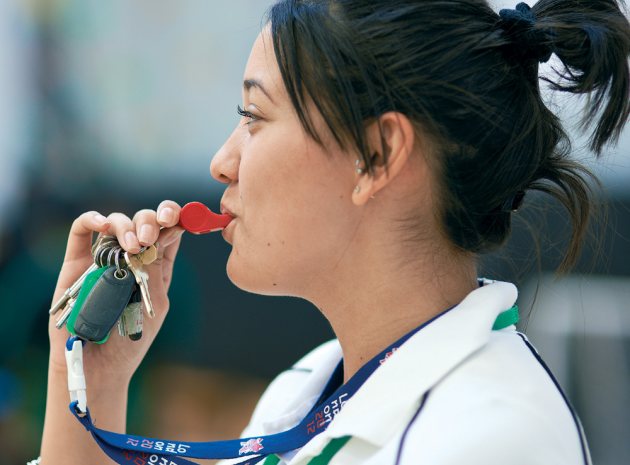Ben Solly has some suggestions for turning a simple session on circuit training into an exciting opportunity for students to take the lead…
Today you will…
- Come to understand the concept of ‘progressive overload’ and the FITT principle
- Develop communication and leadership skills
There has never been a more crucial time for teachers of physical education to fight their corner and shout from the rooftops about the value of their subject. The government is making a hash of the Olympic legacy by selling off playing fields and scrapping the compulsory two hours per week of PE lessons. The successful and inclusive Sports College movement that spawned the SSCO and School Sports Partnership programme has been replaced by an elitist emphasis on competitive sport. Therefore teachers around the country will need to utilise every ounce of their ample resilience to demonstrate how PE can raise aspirations and engender a lifelong participation in physical activity.
The modern day PE teacher is far removed from the Brian Glover-esque characters that put off so many kids in the past, and to engage young people today a successful curriculum model needs to be inclusive, varied and relevant. Here is an approach that you could take to transform a potentially mundane activity such as circuit training into an exciting and engaging lesson, where students are given ownership, and where leadership, communication and co-operation skills are fostered.
Traditionally, learning objectives are shared with students at the start of the lesson, but the best way to create ownership of learning is to ask students to create them, or at least have some input into what they will be. I also like to have a ‘mystery lesson’ occasionally, where you say to the students that you are not going to tell them the learning objectives at the start, but you will ask them at the end to design what they think the objectives could have been and also what they think their next stage of learning might be.
Starter activity
Students should be active and engaged in a learning activity as soon as they enter the sports hall and group activities are great for differentiation and beginning a lesson positively. To achieve an efficient start to the lesson it is good practice to have groups displayed in the changing rooms, so students know exactly where to go and with whom to work. Leadership roles can be delegated quickly by doing this too.
The starter could be based on prior learning that is a key part of the lesson. My suggestion here would be to have different station cards, each with a circuit training activity on them, placed around the sports hall. Students have to race around collecting them and then arrange them in the most suitable order (i.e. not having consecutive stations that exercise the same muscle group). Differentiation could be achieved by having certain coloured cards having less/more information on them for specific groups. Students would have five minutes to complete this, followed by a warm up in their individual groups, which is student led. I always like to delegate specific roles for this, with different learners being responsible for the heart raising, mobility and stretching parts of the warm up. Other group members without a role can act as evaluators and comment on the effectiveness of communication and content of the warm up.
Main activities
The main section of the lesson is based on students adapting basic circuit training stations by making them specific to a sport or position, and to identify how the station can be made progressively more difficult (overload).
Students complete a short circuit of five stations for a minute each. Each station has a card outlining how to carry out that activity. They are then asked to go back to the station they began the circuit at and come up with as many ways as they can of making it more difficult to complete, i.e. overloading the circuit.
Learners should be asked to select the one method of overload from their list they prefer, then one from each group stays at their station whilst the rest rotate around the circuit again, this time completing the overloaded activity led by the student at each station.
During the plenary students can reflect on the ways in which the stations were overloaded and the FITT principle can be drawn out of the discussion. Future lessons in a unit of work could focus on the whole group working together to create a circuit, with pairs creating differentiated stations – coming up with easy, medium and hard versions (applying the FITT principle) of the activity – which can then be put together in a whole group circuit ensuring that the stations are not replicated and are organised correctly. This could lead into students working together to create their own circuits focusing on a specific component of fitness or activity.
Students could be asked to create differentiated circuit cards with written instructions, diagrams and there is potential use of IT, too, with links to videos via a QR code that participants could scan using a mobile phone or iPod to see how each station should be carried out. This allows students to think about providing for different learning styles as well as fitness levels.
Additional resources
Use the station cards created by students as a resource for use within the PE department.
Stretch them further
More able students should be used to model effective leadership skills initially, and encouraged to develop the themes for future learning. differentiated roles within group tasks will ensure students with varying expertise are stretched accordingly. students with interests in ict and digital technology can be tasked with creating qr codes for stations, then teaching other students how to do this.
Summary
Summative assessment can come through the content of and delivery of the final circuit, which students could lead over a few sessions, with two pairs leading their circuit for half of the group at the same time. After each session, self and peer assessment of the circuits could take place whilst the next group are setting up their stations. Assessment could take place using a tick sheet with criteria required for the effective delivery of circuit training linked to National Curriculum levels. Space for comments from students allows detailed feedback including ways in which the circuit and delivery could be improved. This also allows the evaluating and improving skills of students to be assessed. These criteria could be developed with students prior to this final task being set so they can contribute their ideas of effective circuit training, allowing the teacher to assess their knowledge and understanding of circuit training at this point. It also gives students some ownership of the task, which can be extremely motivating.
Home learning
- Ask students to research different activities for stations away from the usual sit-ups and press-ups etc.
- Learners could also be asked to record videos to use for cards/ creation of cards.
About the expert
Ben Solly is Vice Principal at Long Field Academy in Melton Mowbray, and a former Advanced Skills Teacher of Physical Education. You can follow him on Twitter @ben_solly










Ben Solly has some suggestions for turning a simple session on circuit training into an exciting opportunity for students to take the lead…